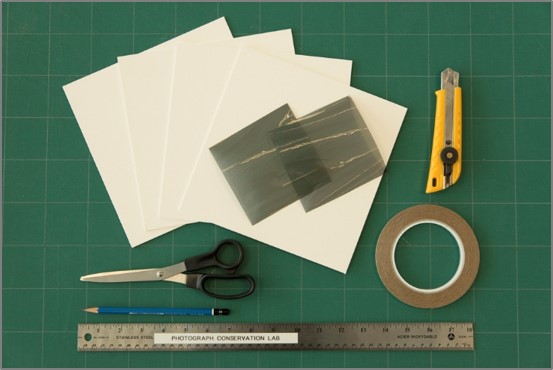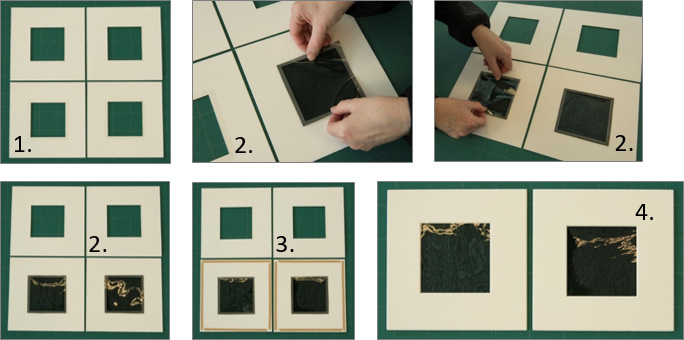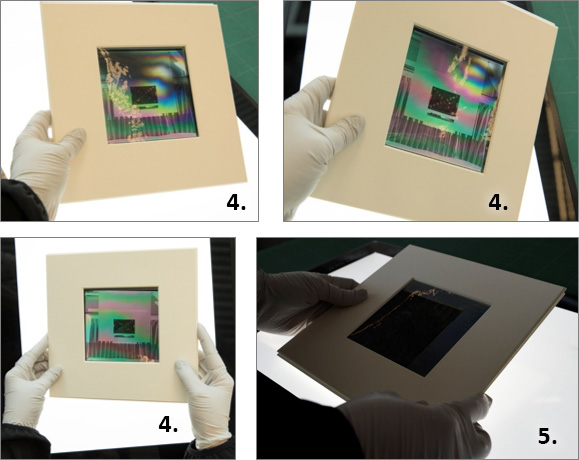Polarizing viewer
On this page

Identification
- This non-destructive test can be used to determine if a negative is either cellulose acetate or cellulose nitrate rather than polyester.
- Note this test can not differentiate between cellulose acetate and nitrate bases.
Materials and Tools
Materials
- clear double-sided tape
- 2-ply mat board, Photographic Activity Test (PAT)Footnote 1 approved
- two polarizing filters/films (H10.5 x W10.5 cm)
Tools
- scissors
- ruler
- Exacto knife or mat cutter

Measuring and Cutting
- Cut four pieces of mat board to external dimensions: H 18 x W 18 cm
- Cut four inside windows within centre: H 9 x W 9 cm
- Cut two polarizing filters/films: H 10.5 x W 10.5 cm

Assembling
- On two mat boards, place a piece of clear double-sided tape above each side of the centre openings.
- On two mat boards, place the polarizing filter/film on the double-sided tape to cover the centre opening.
- Tape the two mat boards with the polarizing filters/film to the two remaining mat boards.
- Together these make the polarizing viewer.

Orientation / Complete Polarizing Viewer
- Place the two mat boards with filters on top of each other. If the filters/films are transparent, they are not polarized.
- Turn one mat board with filter 90 degrees.
- If the filters/films are opaque or black, they are successfully polarized.

Identification with Polarizing Viewer
- Using gloves to handle the negative, place it between the two polarizing filters/films that are in polarized orientation.
- Hold the polarizing viewer firmly together to prevent the negative from slipping out.
- Observe the thinnest possible density of the negative through the polarizing viewer (the outer clear edge is a good choice) while gradually tilting it.

- If a rainbowFootnote 2 pattern becomes visible, then the negative support is polyester.
- If no rainbow colours are visible and the polarizing filter/ film remains black, then the negative is on an acetate support.

Bibliography
National Parks Service. Completing the Polarization Test: How to Make and Use a Film Viewer.
Bennett, Karen L. and Jessica S. Johnson. “Identification of Film-Base Photographic Media,” National Parks Service Conserve O Gram, No. 14/9, 1999.
Fischer, Monique C. and Andrew Robb. “Guidelines for Care and Identification of Film-Base Photographic Materials,” Topics in Photographic Conservation, American Institute of Conservation. Vol. 5, 1993.
Fischer, Monique. “A Short Guide to Film-Based Photographic Materials: Identification, Care and Duplication,” NEDCC Technical Leaflet, updated 7/2012.
Reilly, James. The IPI Storage Guide for Acetate Film. Rochester, New York: Image Permanence Institute, Rochester Institute of Technology, 1993.
Acknowledgements
Tania Passafiume
Head Conservator of Photographic Materials
Carla Klück
Digitization Project Co-ordinator (acting)
Anna Lehn
English Editor